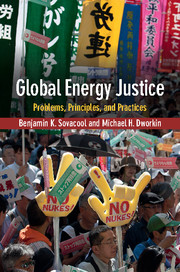Book contents
- Frontmatter
- Epigraph
- Dedication
- Contents
- Analytical table of contents
- List of figures
- List of tables
- Acknowledgements
- List of abbreviations
- 1 Introduction
- 2 The global energy system
- 3 Virtue and energy efficiency
- 4 Utility and energy externalities
- 5 Energy and human rights
- 6 Energy and due process
- 7 Energy poverty, access, and welfare
- 8 Energy subsidies and freedom
- 9 Energy resources and future generations
- 10 Fairness, responsibility, and climate change
- 11 The imperative of making just energy decisions
- Index
- References
8 - Energy subsidies and freedom
Published online by Cambridge University Press: 05 October 2014
- Frontmatter
- Epigraph
- Dedication
- Contents
- Analytical table of contents
- List of figures
- List of tables
- Acknowledgements
- List of abbreviations
- 1 Introduction
- 2 The global energy system
- 3 Virtue and energy efficiency
- 4 Utility and energy externalities
- 5 Energy and human rights
- 6 Energy and due process
- 7 Energy poverty, access, and welfare
- 8 Energy subsidies and freedom
- 9 Energy resources and future generations
- 10 Fairness, responsibility, and climate change
- 11 The imperative of making just energy decisions
- Index
- References
Summary
In 1954, US President Dwight Eisenhower faced a difficult situation. Under the Atoms for Peace Program, announced in December 1953 to the UN General Assembly, he had pledged to “strip the atom’s military casing and adapt it to the art of peace.” The central theme behind Atoms for Peace was to demonstrate that the power of the atom could be converted from a terrifying military force into a benign commodity. A secondary driver, less obvious but still salient, was competition with the Soviet Union. Developments outside the nuclear industry during the 1940s and 1950s, such as the Alger Hiss case, the pro-Soviet coup in Czechoslovakia, the Soviet blockage of West Germany, the Chinese revolution, and Soviet progress developing atom bombs, hydrogen bombs, and nuclear reactors convinced many American planners that they were in a “race to save the world from communism.” Atomic energy was one key component of winning this race, and the reason for choosing to go forward was not necessarily to produce a “cost competitive” nuclear power plant but to demonstrate to the world the superiority of American engineering prowess. The role of the government, in other words, was to be an entrepreneurial custodian of atoms. Yet, atomic energy was then far from technically or economically feasible.
How, then, were Eisenhower and his planners to, first, decide whether his program should be done by the government as opposed to private industry? Secondly, if it was to be government sponsored, how was he to convince investors, vendors, and taxpayers to participate? The Eisenhower Administration’s answer was a program of lavish public subsidies, earmarking billions of tax dollars for research, development, demonstration projects, and offering limited liability guarantees for nuclear accidents. In the American case, government created a market for nuclear power, rather than seeing one emerge organically.
- Type
- Chapter
- Information
- Global Energy JusticeProblems, Principles, and Practices, pp. 256 - 287Publisher: Cambridge University PressPrint publication year: 2014



